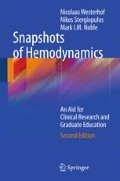Abstarct
Figure 24.1 shows the three-element Windkessel as model for the load on the heart. This (hydraulic) model) as load of the real heart results in ventricular and aortic pressure and aortic flow that are similar to those measured in vivo Three Windkessel models are given in Fig. 24.2. Otto Frank, 1899, popularized the original two-element Windkessel. He reasoned that the decay of diastolic pressure in the ascending aorta, when flow is zero, can be described by an exponential curve. The time constant, τ, i.e., the time for pressure to decrease to 37% of the starting pressure, is given by the product of peripheral resistance, R p , and the total arterial compliance, C, τ = R p C. The larger the resistance the slower the blood, stored in the compliant conduit vessels, leaves the system and the longer the time constant will be. Also, the larger the compliance the more blood is stored, and the longer the time constant will be. Frank’s objective was to derive Cardiac Output from aortic pressure. By measuring the pulse wave velocity over the aorta (carotid to femoral) together with, averaged, cross-sectional area, and using the Newton-Young equation (Chap. 20) area compliance, C A , can de estimated. When aortic length is also known volume compliance, C, is derived. Using τ and C, the peripheral resistance can be calculated from R p = τ/C. From mean pressure and resistance, using Ohm’s law, mean flow is then found. The assumption that all compliance is located in the aorta, thus neglecting the compliance of the smaller conduit vessels, introduces a small error. After pulsatile flows could be measured, and arterial input impedance could be determined (Chap. 23), the shortcomings of the two-element Windkessel became clear.
Access this chapter
Tax calculation will be finalised at checkout
Purchases are for personal use only
References
Westerhof N, Lankhaar JW, Westerhof BE. The arterial Windkessel. Med Biol Eng Comput2009;47:131–141.
Westerhof N, Elzinga G, Sipkema P. An artificial system for pumping hearts. J Appl Physiol1971;31:776–781.
Stergiopulos N, Westerhof BE, Westerhof N. Total arterial inertance as the fourth element of the windkessel model. Am J Physiol 1999;276:H81–H88.
Elzinga G, Westerhof N. Pressure and flow generated by the left ventricle against different impedances. Circ Res 1973;32:178–186.
Stergiopulos N, Meister J-J, Westerhof N. Evaluation of methods for estimating total arterial compliance. Am J Physiol 1995;268:H1540–H1548.
Hamilton WF, Remington JW. The measurement of the stroke volume from the pressure pulse. Am J Physiol 1947;148:14–24.
Chemla D, Hébert JL, Coirault C, Zamani K, Suard I, Colin P, Lecarpentier Y. Total arterial compliance estimated by stroke volume-to-aortic pulse pressure ratio in humans. Am J Physiol 1998;274:H500–H505.
Segers P, Brimioulle S, Stergiopulos N, Westerhof N, Naeije R, Maggiorini M, Verdonck P. Pulmonary arterial compliance in dogs and pigs: the three-element windkessel model revisited. Am J Physiol 1999;277:H725–H731.
Liu Z, Brin KP, Yin FCP. Estimation of total arterial compliance: and improved method and evaluation of current methods. Am J Physiol 1986;251:H588–H600.
Randall OS, Esler MD, Calfee RV, Bulloch GF, Maisel AS, Culp B. Arterial compliance in hypertension. Aust N Z J Med 1976;6:49–59.
Self DA, Ewert RD, Swope RP, Latham RD. Beat-to-beat estimation of peripheral resistance and arterial compliance during +Gz centrifugation. Aviat Space Environ Med 1994;65:396–403.
Stergiopulos N, Meister J-J, Westerhof N. Simple and accurate way for estimating total and segmental arterial compliance: the pulse pressure method. Ann Biomed Eng 1994;22:392–397.
Toorop GP, Westerhof N, Elzinga G. Beat-to beat estimation of peripheral resistance and arterial compliance during pressure transients. Am J Physiol 1987;252:H1275–H1283.
Segers P, Stergiopulos N, Westerhof N. Quantification of the contribution of cardiac and arterial remodeling in hypertension. Hypertension 2000;36:760–765.
Author information
Authors and Affiliations
Corresponding author
Rights and permissions
Copyright information
© 2010 Springer US
About this chapter
Cite this chapter
Westerhof, N., Stergiopulos, N., Noble, M.I.M. (2010). The Arterial Windkessel. In: Snapshots of Hemodynamics. Springer, Boston, MA. https://doi.org/10.1007/978-1-4419-6363-5_24
Download citation
DOI: https://doi.org/10.1007/978-1-4419-6363-5_24
Published:
Publisher Name: Springer, Boston, MA
Print ISBN: 978-1-4419-6362-8
Online ISBN: 978-1-4419-6363-5
eBook Packages: MedicineMedicine (R0)

